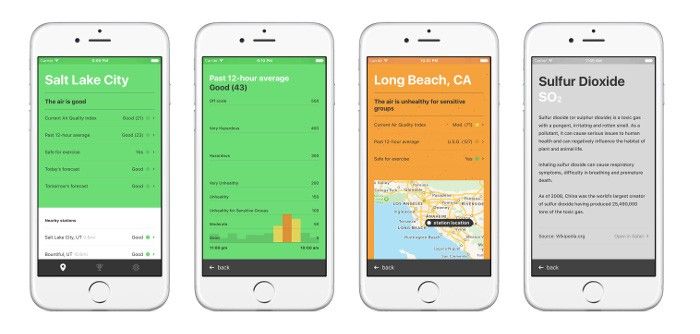“You can look outside and see whether it’s smoggy or not, but that’s not always the indication of air quality. The task is how do you explain that in a really easy, simple way?”
When I was 18, I attended college at Utah State University. This was the first time I had lived outside my parents house and because of this, I started doing certain things to make myself feel like the adult I knew I was: watching CNN, eating lettuce, all sorts of grownup things. As part of this new adult-based regimen, I also started running, which studies have confirmed is the most adult thing anyone can ever do, narrowly edging out making snide remarks to all your single friends about their lack of commitment to a relationship.
At first, my running career went well. I pounded the pavement for 3 months, working up a sweat and taking pride in my newfound sense of accomplishment — so this is what it’s like to be an adult, I thought to myself, nursing sore feet, a creaky back, and nibbling on a protein bar. Unfortunately, my running career changed forever when winter set in. If you haven’t felt a Logan, Utah winter, I would advise against it, because it seeps deep into your bones and convinces you warmth is an illusion that never existed. At the time, I wasn’t aware of this. The first wintry night, when all was calm and snow piled up in marshmallowy mounds around my dorm room, I laced up my running shoes, threw on a few extra layers, and began running into the coldest part of hell. In about 2 minutes, I began coughing. Not a run-of-the-mill cough generally associated with basic human throat clearing, I’m talking about a cough that can only be mustered by someone who has smoked three packs of cigarettes every day for 60 straight years, or by an 18-year-old clown who thought running through Logan in subzero temperatures would be a very adult thing to do. By the time I had finished, my lungs were shredded, I swore off running, and I abandoned the notion that I was a capable adult who understood things like smog and its effects on the human body.
Now, I am an actual adult. At least for the most part, because I check the weather daily and realize there are ways to monitor air quality before deciding to exercise in the great outdoors. One of those ways is Air Lookout, an app created by Geof Crowl for users to easily monitor and understand air pollution levels. If I could go back in time and hand this app to my 18-year-old self on a silver platter, I would.
“In my opinion, the least amount of time people have to spend in my app to get the information they need, the better,” said Crowl. “I don’t want them to feel like they’re stuck in there trying to find whatever bit of information they need. Air Lookout very clearly tells you the location, whether the air is currently good or not, what the past 12 hours have been like, what the forecast (if available) is looking like, and whether it’s safe to exercise or not.”
Simple is good, especially in the world of technology. I don’t want an app with tons of confusing and unlabeled buttons (I’m looking at you, Snapchat), I want an app that is easy to use. When I go into the Air Lookout homescreen, this is exactly what I get — if the air is good, it says “The air is good.” Of course, if I want to examine the more advanced numbers that go into determining air quality (carbon monoxide, particulates, ozone, etc), I can do that as well.
So by now you’re probably thinking, where is this data coming from? Does Crowl stand outside day and night, holding one finger in the air, madly typing everything he feels into the Air Lookout app? Actually, the data is pulled from the most logical place possible — the Environmental Protection Agency (EPA). With over 2,500 air quality stations spread throughout North America, the EPA has streams of data that haven’t really been harnessed in a standardized, easy-to-use way. That’s where Air Lookout comes in.
“It’s easy to communicate weather because it’s much more experiential,” said Crowl. “If you say it’s raining, people are familiar with the concept of rain….When you’re talking about air quality, it’s a little bit more obtuse. You can look outside and see whether it’s smoggy or not, but that’s not always the indication of air quality. The task is how do you explain that in a really easy, simple way?”
Since the app store was created, Crowl has been designing apps. He built a simple tic-tac-toe game for his first go-round, using it as a vessel to explore the world of app building — what works, what doesn’t, and what could be changed about his process.
“I wanted to make as many mistakes as possible, as soon as possible,” said Crowl. “Not belligerently making mistakes but just exposing myself to those mistakes and being aware of them, what my weaknesses are and what I need to learn.”
With help from this mistake-heavy approach, Crowl has built Air Lookout on what he believes is a solid foundation, one that won’t crumble when he adds or tweaks features, and one that can continue to provide air quality data in the easiest manner possible.
“The big goal for me on the 1.0 release was to have good visual language for communicating air quality,” said Crowl. “Just a simple building block that I could keep building on for subsequent versions, have more of a design evolution rather than constantly having to redo or reinvent the app.”




